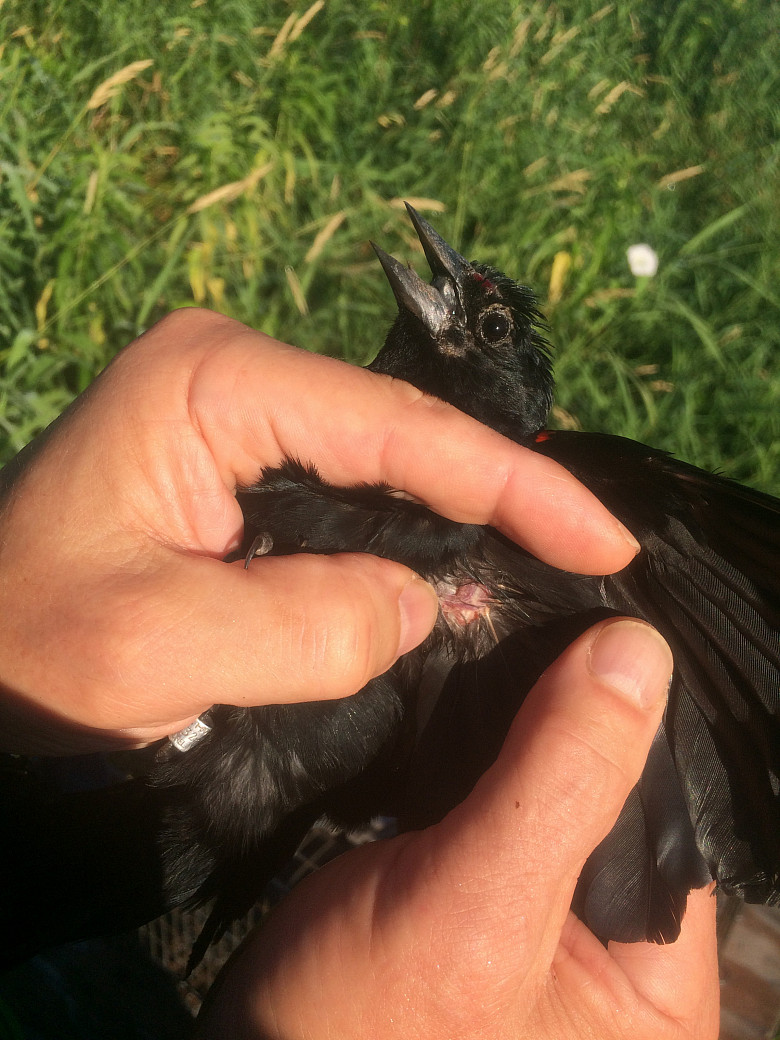Genetic Research on Live Red-Winged Blackbirds
Scientific Reports, an open-access journal of Nature, recently published an article detailing research conducted by Beloit alumnus, Michael Lafayette‘20 and professor emeritus, Ken Yasukawa, in cooperation with five researchers at the University of Illinois. The research involved playing audio recordings of male Red-winged Blackbirds, female Brown-headed Cowbirds, and Mourning Doves to male Red-winged Blackbirds, capturing the blackbirds within 30 minutes, and obtaining blood samples to describe how blackbird genes respond to threats from potential rivals (other redwings) and brood parasites (female cowbirds, which lay their eggs in redwing nests), and to doves, which do not pose a threat. Yasukawa noted that his many years of experience in the field were essential to his success in capturing the birds in only 30 minutes, as the research required. The responses to cowbirds were summarized in The Wildlife Society’s Red-winged Blackbirds’ genes change when cowbirds are near by Dana Kobilinsk. It was already known that redwings are aggressive towards cowbirds.
What were the biggest challenges in collecting the blood samples for this experiment?
Biologists who work in the field spend tremendous time and effort to capture and then mark individual subjects for study. I began studying Red-winged Blackbirds in 1973 in southern Indiana during my graduate research and, during my long research career, I slowly learned to capture birds in traps. If you only need to trap a bird once, the task is difficult but possible, though not in 100% of cases. However, one trapping experience often makes it impossible to recapture the same bird–it becomes “trap shy.” Our challenge was not only to capture some redwings for the first time, but to recapture many that had been trapped and marked in previous years, and to do it within 30 minutes to make sure that we could detect the “immediate early” gene products. I had to use my decades of trapping experience and, although we were generally successful, we were unable to catch a third of our playback subjects within our 30-minute window. Then, I had to collect blood from each captured bird, add a buffer and store the samples in an ultra-cold freezer, and send the frozen samples to the University of Illinois for mRNA analysis. In a few cases, the mRNA analysis did not work properly, but we were able to generate enough usable information to publish our results in Scientific Reports, a well-regarded, peer-reviewed journal.
What new information were you able to gather when studying live Red-winged Blackbirds, as opposed to dead birds?
Previous studies of gene expression have focused on the brain, which of course requires the brain to be removed, processed, and viewed with a microscope. Although such studies provide information about what is produced during gene expression and where the products act in the brain, there is no way to make a direct connection to behavior. More recent methods have used gene products (mRNA) found in circulating blood, but these studies were done on captive birds that were sacrificed to collect their blood and brains. In contrast, because we studied free-living, individually-marked, known birds on their territories, we could present them with specific, relevant situations using playback of three kinds of audio recordings, observe and record their responses, and then immediately capture them and take blood samples for mRNA analysis. We could see rapid changes in their gene expression in real-time in living birds! Note that the playbacks and observations were performed by my student, Michael Lafayette (’20), a chemistry major who will begin graduate study in Molecular Sciences at Arizona State University.
How else do you think RNA analysis of live birds will be useful in future studies?
The general method we used is called “transcriptome analysis,” which has revolutionized biology and medicine in the past 10 years. The RNA-seq method we employed is complex and highly technical, so our collaboration with co-authors at the University of Illinois was essential. These analyses can be used to study how cells differentiate, how cells become cancerous, the regulation of gene expression, and evolutionary relationships. Biologists have long speculated about the link between genes and behavior, and more recently, that immediate early gene expression in response to relevant stimuli must be that proximate link. Our results provide a path to explore this fundamental relationship between genetics and animal behavior. What better way to end my research career?
Share:
Open gallery

Related Stories


